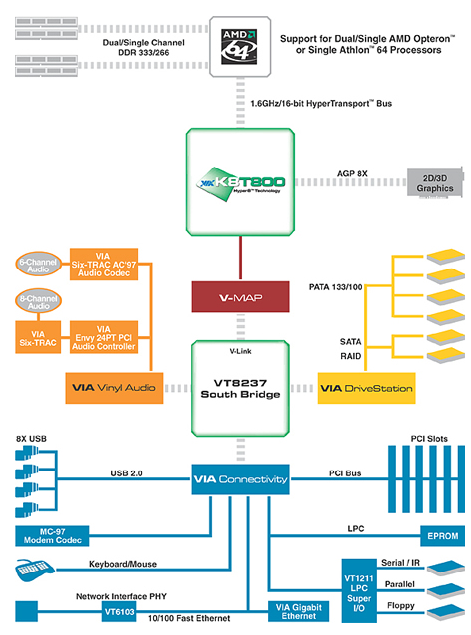VIA's K8T800
A new form-factor requires a new raft of motherboards. The jump from S462 to S754 is such that no 'slocket' will be of much use in this instance. Two of AMD's long-term chipset partners have come to the fore and provided solutions for both Socket 940 and Socket 754. Unsurprisingly, the duo are VIA and NVIDIA; keen competitors for the S462 range of CPUs. We've got retail examples of both companies' Socket-754 Clawhammer boards from EPoX and Shuttle respectively. In the blue corner, hailing from Taiwan, is VIA's K8T800 Clawhammer, represented by the EPoX 8HDA3+. In the red corner, from sunny California, is NVIDIA's nForce3 150, ably represented by Shuttle's AN50R. They aim to do the same thing, that is, provide superb Clawhammer support and class-leading performance. Both companies have a history of producing top-notch boards that are as stable as the day is long. The question is who makes the better single-channel AMD Athlon 64 chipset ?. Let's try to find out.
What better way to start off a look at VIA's K8T800 than by perusing its block diagram. So here we go.

It's sensible to head from top to bottom. It's interesting to note that it supports the Athlon 64 FX / single Opteron / Athlon 64, obviously not at the same time. The reasoning is simple. The memory controller, something that chipset manufacturers had to get right themselves before AMD's on-die inclusion, is now incorporated into the CPUs. It's just a matter of VIA's partners choosing the CPU that the board's to be based upon. A simple swap-out from a 754-pin Clawhammer to a 940-pin Opteron 1xx or Athlon 64 FX is a case of changing the socket form factor and scant little else. There's compatibility for you. The chosen processor then links to the barren North Bridge via AMD's HyperTransport link, here shown running at 1.6GHz, and providing up to 3.2GB/s bandwidth in each direction. VIA makes noises about its Hyper8 technology, which, it reckons, eliminates noise on the HyperTransport link between the CPU and the K8T800. That's why VIA tout the 6.4GB/s link as a feature.
VIA's also chosen a traditional VMAP North / South Bridge formation. We suppose it can opt to change either with less difficulty than a single-chip design. Incidentally, the block diagram shows DRAM controller support for DDR266 and DDR333 memory, be it single or dual channel. That's a little out of date, as the K8T800 runs with DDR400 memory just fine. From a Clawhammer's perspective, that memory is regular RAM. Pick up any unbuffered stick and it will work; there's no need for registered memory unless we're dealing with FXs and Opterons. The K8T800 Northbridge's main duty is in liaising with the graphics card at up to 2.1GB/s (AGP 8x).
The VT8237 South Bridge has seen outings before. It's presently specified on the PT800 (P4) and KT600 (AMD) chipsets, and it's connected to the K8T800 via a 533MB/s V-Link. Let's have a closer look at its constituent parts.
VIA's Drivestation features native Serial ATA implementation through a 150MB/s dual channel SATA interface (2 SATA drives capable of RAID0 and RAID1) which runs on-chip. No PCI bus hogging here, folks. VIA further adds to its SATA appeal by a SATALite interface that allows the adding of two further SATA drives from an external PHY (Silicon Image physical layer), thereby affording 4 SATA drives in total and the ability to run RAID0+1. One must bear in mind that the PHY will take the place of the secondary PATA channel. The 4 possible drives gives rise to a number of weird and wonderful RAID formations that fall under the banner of V-RAID, such as RAID0 (striping), RAID1 (mirroring), RAID0+1 (striping and mirroring, 2 drives on each), and JBOD (Just a Bunch Of Disks).
Let's also not forget the 2 standard ATA133-capable PATA channels, which all means that one can connect no less than 6 drives (4 SATA + 2 PATA or 4 PATA + 2 SATA, depending on whether the SATALink is used ) to the VT8237 South Bridge. It doesn't appear as if 533MB/s is enough bandwidth to serve all these devices concurrently, especially if the Gigabit LAN option is implemented. We need some Intel-like CSA lovin'
The '8237's VIA Connectivity features support for 8 USB 2.0 ports, but there's no provision for the other high-speed format we love, FireWire. Audio is becoming increasingly important on the very latest motherboards, so VIA offers manufacturers a couple of options. There's integrated 6-channel sound from the Six-TRAC CODEC that boasts 20-bit resolution, a 90dB Signal-to-noise ratio and a spiffy Stylus driver that incorporates Sensaura technology, or one could opt for the Vinyl Audio Gold onboard 7.1-channel surround sound solution powered by the impressive Envy24PT chip, which carries 8-channel support, 24-bit resolution and sampling rates as high as 96KHz. Of course, manufacturers are free to choose whichever sound subsystem they wish.
The K8T800 is a chipset born through mature development in the K7-series ranks. It's a simple and powerful design that lends itself to each and every uniprocessor-based AMD 32/64-bit CPU









